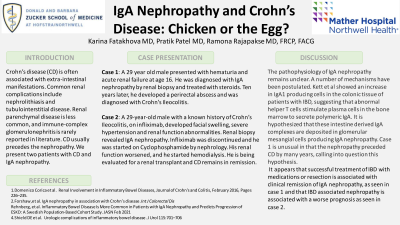Back

Poster Session B - Monday Morning
Category: IBD
B0427 - IgA Nephropathy and Crohn’s Disease: Chicken or the Egg?
Monday, October 24, 2022
10:00 AM – 12:00 PM ET
Location: Crown Ballroom


Karina Fatakhova, MD
Northwell Health at Mather Hospital
Port Jefferson, New York
Presenting Author(s)
Karina Fatakhova, MD1, Pratik Patel, MD2, Ramona Rajapakse, MD3
1Northwell Health at Mather Hospital, Port Jefferson, NY; 2Northwell Health at Mather Hospital, Middle Island, NY; 3Mather Hospital, Port Jefferson, NY
Introduction: Crohn’s disease (CD) is often associated with extra-intestinal manifestations. Common renal complications include nephrolithiasis and tubulointerstitial disease. Renal parenchymal disease is less common, and immune-complex glomerulonephritis is rarely reported in literature. CD usually precedes the nephropathy. We present two patients with CD and IgA nephropathy.
Case Description/Methods:
Case 1: A 29 year old male presented with hematuria and acute renal failure at age 16. He was diagnosed with IgA nephropathy by renal biopsy and treated with steroids. Ten years later, he developed a perirectal abscess, was diagnosed with Crohn’s ileocolitis and started Infliximab infusions. Both the IgA nephropathy and CD remained stable.
Case 2: A 29-year-old male with a known history of Crohn’s ileocolitis, on infliximab, developed facial swelling and severe hypertension. Labs: BUN 86 mg/dL and creatinine 3.86 mg/dL. Renal biopsy revealed IgA nephropathy. Infliximab was discontinued and he was started on Cyclophosphamide by nephrology. His renal function worsened, and he started hemodialysis. He is being evaluated for a kidney transplant and CD remains in remission.
Discussion: The pathophysiology of IgA nephropathy remains unclear. A number of mechanisms have been postulated. Kett et al showed an increase in IgA1 producing cells in the colonic tissue of patients with IBD, suggesting that abnormal helper T cells stimulate plasma cells in the bone marrow to secrete polymeric IgA. It is hypothesized that these intestine derived IgA complexes are deposited in glomerular mesangial cells producing IgA nephropathy. Case 1 is unusual in that the nephropathy preceded CD by many years, calling into question this hypothesis.
Genetic factors may play a role, HLA-DR1 maybe a potential link between the two diseases. Environmental factors have been considered as well. Median age of onset for IgA nephropathy is 22 yrs, with a range of 10-36y yrs. Symptoms can range from gross hematuria, hypertension, and edema to acute renal failure. It appears that successful treatment of IBD with medications or resection is associated with clinical remission of IgA nephropathy, as seen in case 1 and that IBD associated nephropathy is associated with a worse prognosis as seen in case 2. It is important to consider IgA nephropathy as a differential diagnosis in patients who present with signs of renal impairment in order to prevent adverse outcomes.
Disclosures:
Karina Fatakhova, MD1, Pratik Patel, MD2, Ramona Rajapakse, MD3. B0427 - IgA Nephropathy and Crohn’s Disease: Chicken or the Egg?, ACG 2022 Annual Scientific Meeting Abstracts. Charlotte, NC: American College of Gastroenterology.
1Northwell Health at Mather Hospital, Port Jefferson, NY; 2Northwell Health at Mather Hospital, Middle Island, NY; 3Mather Hospital, Port Jefferson, NY
Introduction: Crohn’s disease (CD) is often associated with extra-intestinal manifestations. Common renal complications include nephrolithiasis and tubulointerstitial disease. Renal parenchymal disease is less common, and immune-complex glomerulonephritis is rarely reported in literature. CD usually precedes the nephropathy. We present two patients with CD and IgA nephropathy.
Case Description/Methods:
Case 1: A 29 year old male presented with hematuria and acute renal failure at age 16. He was diagnosed with IgA nephropathy by renal biopsy and treated with steroids. Ten years later, he developed a perirectal abscess, was diagnosed with Crohn’s ileocolitis and started Infliximab infusions. Both the IgA nephropathy and CD remained stable.
Case 2: A 29-year-old male with a known history of Crohn’s ileocolitis, on infliximab, developed facial swelling and severe hypertension. Labs: BUN 86 mg/dL and creatinine 3.86 mg/dL. Renal biopsy revealed IgA nephropathy. Infliximab was discontinued and he was started on Cyclophosphamide by nephrology. His renal function worsened, and he started hemodialysis. He is being evaluated for a kidney transplant and CD remains in remission.
Discussion: The pathophysiology of IgA nephropathy remains unclear. A number of mechanisms have been postulated. Kett et al showed an increase in IgA1 producing cells in the colonic tissue of patients with IBD, suggesting that abnormal helper T cells stimulate plasma cells in the bone marrow to secrete polymeric IgA. It is hypothesized that these intestine derived IgA complexes are deposited in glomerular mesangial cells producing IgA nephropathy. Case 1 is unusual in that the nephropathy preceded CD by many years, calling into question this hypothesis.
Genetic factors may play a role, HLA-DR1 maybe a potential link between the two diseases. Environmental factors have been considered as well. Median age of onset for IgA nephropathy is 22 yrs, with a range of 10-36y yrs. Symptoms can range from gross hematuria, hypertension, and edema to acute renal failure. It appears that successful treatment of IBD with medications or resection is associated with clinical remission of IgA nephropathy, as seen in case 1 and that IBD associated nephropathy is associated with a worse prognosis as seen in case 2. It is important to consider IgA nephropathy as a differential diagnosis in patients who present with signs of renal impairment in order to prevent adverse outcomes.
Disclosures:
Karina Fatakhova indicated no relevant financial relationships.
Pratik Patel indicated no relevant financial relationships.
Ramona Rajapakse indicated no relevant financial relationships.
Karina Fatakhova, MD1, Pratik Patel, MD2, Ramona Rajapakse, MD3. B0427 - IgA Nephropathy and Crohn’s Disease: Chicken or the Egg?, ACG 2022 Annual Scientific Meeting Abstracts. Charlotte, NC: American College of Gastroenterology.
